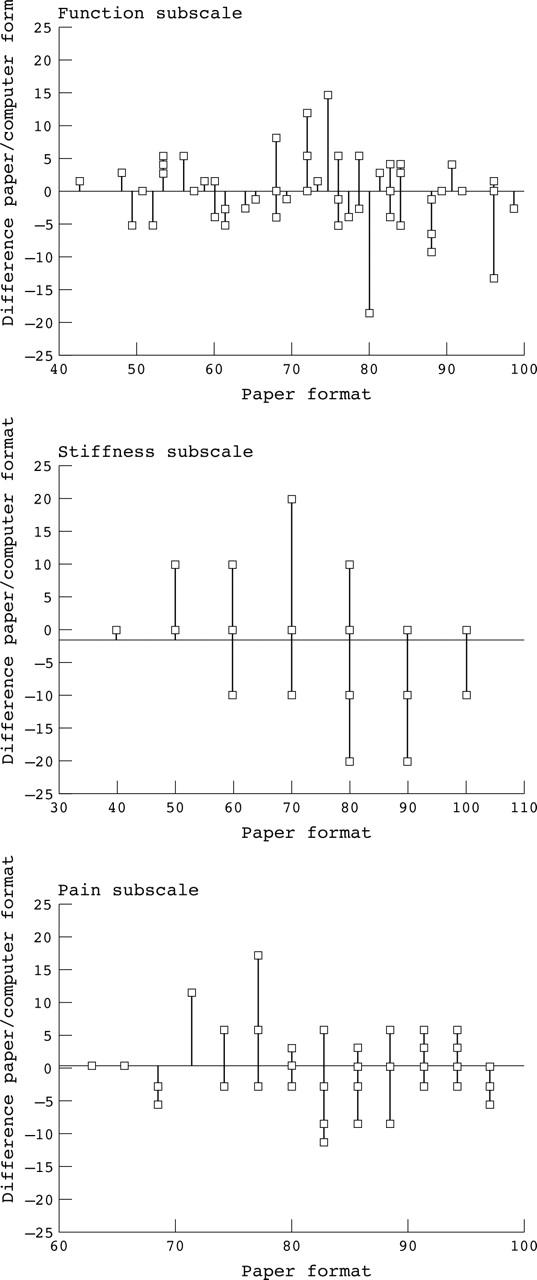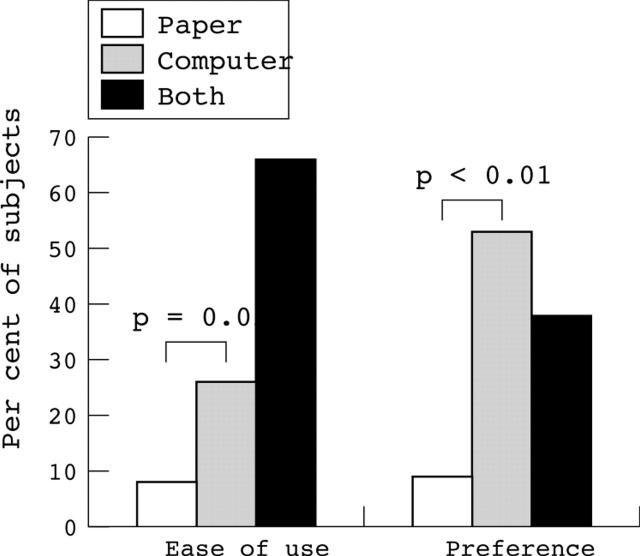Abstract
Objectives: To validate the WOMAC 3.1 in a touch screen computer format, which applies each question as a cartoon in writing and in speech (QUALITOUCH method), and to assess patient acceptance of the computer touch screen version.
Methods: The paper and computer formats of WOMAC 3.1 were applied in random order to 53 subjects with hip or knee osteoarthritis. The mean age of the subjects was 64 years (range 45 to 83), 60% were male, 53% were 65 years or older, and 53% used computers at home or at work. Agreement between formats was assessed by intraclass correlation coefficients (ICCs). Preferences were assessed with a supplementary questionnaire.
Results: ICCs between formats were 0.92 (95% confidence interval, 0.87 to 0.96) for pain; 0.94 (0.90 to 0.97) for stiffness, and 0.96 (0.94 to 0.98) for function. ICCs were similar in men and women, in subjects with or without previous computer experience, and in subjects below or above age 65. The computer format was found easier to use by 26% of the subjects, the paper format by 8%, and 66% were undecided. Overall, 53% of subjects preferred the computer format, while 9% preferred the paper format, and 38% were undecided.
Conclusion: The computer format of the WOMAC 3.1 is a reliable assessment tool. Agreement between computer and paper formats was independent of computer experience, age, or sex. Thus the computer format may help improve patient follow up by meeting patients' preferences and providing immediate results.
Full Text
The Full Text of this article is available as a PDF (74.7 KB).
Figure 2.
Patients' preferences with regard to paper and computer format of the WOMAC (Western Ontario and McMaster Universities osteoarthritis index). Of persons who expressed a preference, there were significantly more who stated that the computer format was easier to use, and more preferred the computer over the paper format.
Figure 1.

Differences between paper and computer format of the WOMAC osteoarthritis index version 3.1 by person and by subscale. The graphs show differences between formats using the paper format as the gold standard for each individual. Squares represent the individuals who had discrepant subscale scores, while identical scores are not shown. The horizontal line gives the mean difference between formats.
Selected References
These references are in PubMed. This may not be the complete list of references from this article.
- Bellamy N., Bensen W. G., Ford P. M., Huang S. H., Lang J. Y. Double-blind randomized controlled trial of flurbiprofen-SR (ANSAID-SR) and diclofenac sodium-SR (Voltaren-SR) in the treatment of osteoarthritis. Clin Invest Med. 1992 Oct;15(5):427–433. [PubMed] [Google Scholar]
- Bellamy N., Buchanan W. W., Goldsmith C. H., Campbell J., Stitt L. W. Validation study of WOMAC: a health status instrument for measuring clinically important patient relevant outcomes to antirheumatic drug therapy in patients with osteoarthritis of the hip or knee. J Rheumatol. 1988 Dec;15(12):1833–1840. [PubMed] [Google Scholar]
- Bellamy N., Campbell J., Stevens J., Pilch L., Stewart C., Mahmood Z. Validation study of a computerized version of the Western Ontario and McMaster Universities VA3.0 Osteoarthritis Index. J Rheumatol. 1997 Dec;24(12):2413–2415. [PubMed] [Google Scholar]
- Bellamy Nicholas. WOMAC: a 20-year experiential review of a patient-centered self-reported health status questionnaire. J Rheumatol. 2002 Dec;29(12):2473–2476. [PubMed] [Google Scholar]
- Buxton J., White M., Osoba D. Patients' experiences using a computerized program with a touch-sensitive video monitor for the assessment of health-related quality of life. Qual Life Res. 1998 Aug;7(6):513–519. doi: 10.1023/a:1008826408328. [DOI] [PubMed] [Google Scholar]
- Ehrich E. W., Davies G. M., Watson D. J., Bolognese J. A., Seidenberg B. C., Bellamy N. Minimal perceptible clinical improvement with the Western Ontario and McMaster Universities osteoarthritis index questionnaire and global assessments in patients with osteoarthritis. J Rheumatol. 2000 Nov;27(11):2635–2641. [PubMed] [Google Scholar]
- Fortin Paul R., Penrod John R., Clarke Ann E., St-Pierre Yvan, Joseph Lawrence, Bélisle Patrick, Liang Matthew H., Ferland Diane, Phillips Charlotte B., Mahomed Nizar. Timing of total joint replacement affects clinical outcomes among patients with osteoarthritis of the hip or knee. Arthritis Rheum. 2002 Dec;46(12):3327–3330. doi: 10.1002/art.10631. [DOI] [PubMed] [Google Scholar]
- Laupacis Andreas, Bourne Robert, Rorabeck Cecil, Feeny David, Tugwell Peter, Wong Cindy. Comparison of total hip arthroplasty performed with and without cement : a randomized trial. J Bone Joint Surg Am. 2002 Oct;84-A(10):1823–1828. doi: 10.2106/00004623-200210000-00013. [DOI] [PubMed] [Google Scholar]
- Lingard E. A., Katz J. N., Wright R. J., Wright E. A., Sledge C. B., Kinemax Outcomes Group Validity and responsiveness of the Knee Society Clinical Rating System in comparison with the SF-36 and WOMAC. J Bone Joint Surg Am. 2001 Dec;83-A(12):1856–1864. doi: 10.2106/00004623-200112000-00014. [DOI] [PubMed] [Google Scholar]
- Nilsdotter A-K, Petersson I. F., Roos E. M., Lohmander L. S. Predictors of patient relevant outcome after total hip replacement for osteoarthritis: a prospective study. Ann Rheum Dis. 2003 Oct;62(10):923–930. doi: 10.1136/ard.62.10.923. [DOI] [PMC free article] [PubMed] [Google Scholar]
- Pham Thao, Van Der Heijde Désirée, Lassere Marissa, Altman Roy D., Anderson Jennifer J., Bellamy Nicholas, Hochberg Marc, Simon Lee, Strand Vibeke, Woodworth Thasia. Outcome variables for osteoarthritis clinical trials: The OMERACT-OARSI set of responder criteria. J Rheumatol. 2003 Jul;30(7):1648–1654. [PubMed] [Google Scholar]
- Stucki G., Sangha O., Stucki S., Michel B. A., Tyndall A., Dick W., Theiler R. Comparison of the WOMAC (Western Ontario and McMaster Universities) osteoarthritis index and a self-report format of the self-administered Lequesne-Algofunctional index in patients with knee and hip osteoarthritis. Osteoarthritis Cartilage. 1998 Mar;6(2):79–86. doi: 10.1053/joca.1997.0097. [DOI] [PubMed] [Google Scholar]
- Theiler R., Sangha O., Schaeren S., Michel B. A., Tyndall A., Dick W., Stucki G. Superior responsiveness of the pain and function sections of the Western Ontario and McMaster Universities Osteoarthritis Index (WOMAC) as compared to the Lequesne-Algofunctional Index in patients with osteoarthritis of the lower extremities. Osteoarthritis Cartilage. 1999 Nov;7(6):515–519. doi: 10.1053/joca.1999.0262. [DOI] [PubMed] [Google Scholar]
- Theiler R., Spielberger J., Bischoff H. A., Bellamy N., Huber J., Kroesen S. Clinical evaluation of the WOMAC 3.0 OA Index in numeric rating scale format using a computerized touch screen version. Osteoarthritis Cartilage. 2002 Jun;10(6):479–481. doi: 10.1053/joca.2002.0807. [DOI] [PubMed] [Google Scholar]
- Wright J. G., Young N. L. A comparison of different indices of responsiveness. J Clin Epidemiol. 1997 Mar;50(3):239–246. doi: 10.1016/s0895-4356(96)00373-3. [DOI] [PubMed] [Google Scholar]



